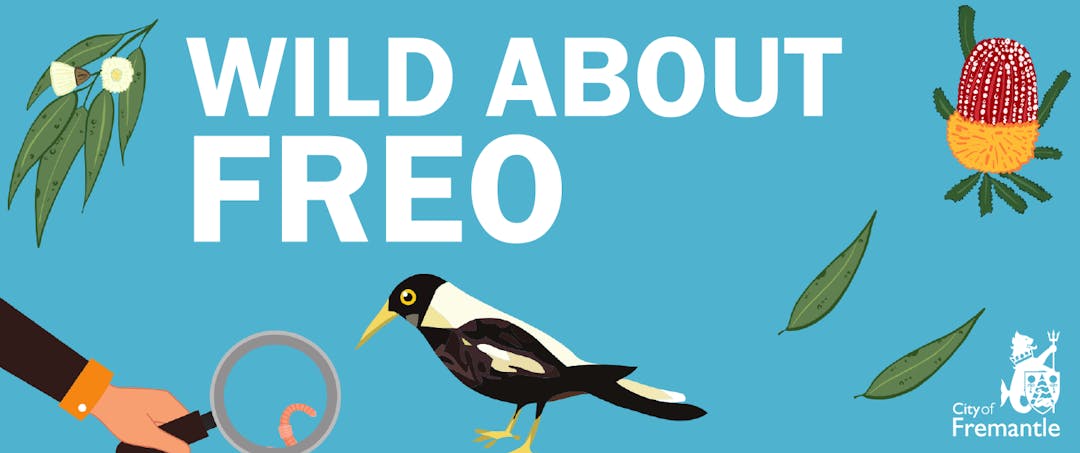Wild About Freo
Consultation has concluded

Record and share your observations around Freo / Walyalup.
Whether you’re an expert, nature lover or you’ve just had more time recently to stop and smell the flowers, we want you to help observe and record what’s wild about Freo! We want to know what you find in your backyard or even when out exercising locally.
We have a variety of environments, from marine on our western border through to tall tuart, jarrah and marri trees at our eastern border in Sir Frederick Samson Park, one of our two bush forever sites. We even have an international flyway overhead!
Many of our plants and animals are found nowhere else. We’re located within the wider south-west WA global biodiversity hotspot, which means the area has over 1,500 vascular plants found nowhere else on earth (endemic) but has also lost over 70% of its primary native vegetation.
Get started! Head to our dedicated Wild About Freo project page on the iNaturalist platform where you can log in or sign up to record your finds. You can also seek advice from the community and aim to move up the leader board! Stay tuned for more news and tips on supporting local biodiversity.
Have fun but please ensure you follow the current health advice in relation to COVID19. For the latest information, visit the WA Department of Health website.
Record and share your observations around Freo / Walyalup.
Whether you’re an expert, nature lover or you’ve just had more time recently to stop and smell the flowers, we want you to help observe and record what’s wild about Freo! We want to know what you find in your backyard or even when out exercising locally.
We have a variety of environments, from marine on our western border through to tall tuart, jarrah and marri trees at our eastern border in Sir Frederick Samson Park, one of our two bush forever sites. We even have an international flyway overhead!
Many of our plants and animals are found nowhere else. We’re located within the wider south-west WA global biodiversity hotspot, which means the area has over 1,500 vascular plants found nowhere else on earth (endemic) but has also lost over 70% of its primary native vegetation.
Get started! Head to our dedicated Wild About Freo project page on the iNaturalist platform where you can log in or sign up to record your finds. You can also seek advice from the community and aim to move up the leader board! Stay tuned for more news and tips on supporting local biodiversity.
Have fun but please ensure you follow the current health advice in relation to COVID19. For the latest information, visit the WA Department of Health website.
-
Welcome to Makuru
Share Welcome to Makuru on Facebook Share Welcome to Makuru on Twitter Share Welcome to Makuru on Linkedin Email Welcome to Makuru link
Here on Noongar boodjar (country), the season of Makuru is nearly upon us - the coldest and wettest time of the year, usually coinciding with June-July.
Blue and purple flowers will start to emerge and animals begin to pair up in preparation for breeding next season. In particular, keep an eye out for 'wardongs' (crows) flying in pairs, and suspiciously quiet as they cease their cawing for a mate.
You might also spot more 'mali' (black swans) on our lakes and rivers as they prepare to nest and breed.
Post your pairs on Wild About Freo's iNaturalist page and contribute to our collection, over 780 observations and counting!
Source: Nyoongar Calendar, Bureau of Meterology via Jason Barrow, ECU
-
Get a tree - for free!
Share Get a tree - for free! on Facebook Share Get a tree - for free! on Twitter Share Get a tree - for free! on Linkedin Email Get a tree - for free! linkDid you know that Fremantle residents can apply to have a street tree planted on their verge at no cost?
Once an application is received, our parks and landscape team will inspect your verge during the following April/May and talk to you about what's most suitable. Planting then happens in the winter months between April - July, to make sure your tree survives.
All you have to do is complete the e-services (Parks & Landscape) form for a New Street Tree, or you can call us at 1300 MY FREO (1300 69 3736).
-
Things that slither
Share Things that slither on Facebook Share Things that slither on Twitter Share Things that slither on Linkedin Email Things that slither linkPerth is home to at least 71 reptile species and is believed to house more reptiles than any other urban area in the world (WWF 2013).
One of the slithery creatures you might spot in the warmer months is the bobtail or shingleback skink, Tiliqua rugosa (Yoorn in Noongar language). Between December and April the females give birth to 2-3 live young, which can be up to 40% of the mother's body weight!
Aside from basking on our roads on warmer days, bobtails love to hide in grasses, leaf litter, paddocks and some gardens. If you want to create a more bobtail-friendly backyard, consider:
- Having a native garden with lots of vegetation, encouraging insects (their food!)
- Creating safe places for them to hide
- Having wet areas for them to drink from
- Using environmentally friendly pest-control and staying away from chemicals
-
Will they or won't they? Waiting for Fairy Terns
Share Will they or won't they? Waiting for Fairy Terns on Facebook Share Will they or won't they? Waiting for Fairy Terns on Twitter Share Will they or won't they? Waiting for Fairy Terns on Linkedin Email Will they or won't they? Waiting for Fairy Terns linkFremantle’s own Rous Head is a major breeding site for Australian Fairy Terns, a vulnerable species of small seabird.
The birds have been seen attempting to breed in the area for many years, however a colony had never been established as their shallow sand nests make them vulnerable to human, predator and vehicle destruction. In 2013 Fremantle Ports established the Rous Head Fairy Tern Sanctuary, providing a safe, enclosed breeding site.
Since then there have been a record six continuous nesting seasons at the Port's Rous Head Fairy Tern Sanctuary and a large increase in colony numbers, however the birds nested at other locations during the 2020 season. Researcher Claire Greenwell says that they change location to be less predictable to predators.
Fairy Terns can arrive anywhere from late November when bait fish become available, so keep your eyes peeled to see them circling as they scout for nesting sites for 2021.
Visit the Fremantle Ports website to find out more about the Fairy Tern Sanctuary.
You can find out more information about the Rous Head sanctuary by clicking here or visiting the Fremantle Ports website.
-
The mysterious WA Christmas tree
Share The mysterious WA Christmas tree on Facebook Share The mysterious WA Christmas tree on Twitter Share The mysterious WA Christmas tree on Linkedin Email The mysterious WA Christmas tree linkChances are you've seen the beautiful Western Australian Christmas tree (Nuytsia floribunda) in flower, but you may not know how special the species really is.
The WA Christmas tree/moojar tree has great significance to Noongar culture and people. Ken Macintyre and Barb Dobson from Anthropology from the Shed say:
"When Noongar spokespersons were interviewed by us... the Elders reported that few people today understand the significance of the moojar tree (Nuytsia floribunda) commonly known as the Western Australian Christmas tree. They said that the moojar was regarded as “highly spiritual” because it was associated with the spirits of the dead who according to the ‘old people’ “camped” on the branches and flowers of the tree on their way to Kurannup – the land of the ancestors across the Western ocean. They said to us: ‘We don’t like to go near this tree.’"
You can read more about this interview by clicking here or visiting the Anthropology from the Shed website.
The WA Christmas tree is also highly unusual. It has no relatives and is the largest mistletoe in the world, and the only one that grows in the ground rather than on the stems of plants. It's also hemi-parasitic, using it's roots to extract water and nutrients from nearby plants - the roots have even been known to invade PVC-wrapped telephone cables.
WA Christmas trees are under ongoing threat from clearing and livestock damage, and replacements are notoriously difficult to grow. By appreciating and understanding their importance we can help protect them.
Keep an eye out for these unique plants between October and January, and make sure to upload any pictures on iNaturalist.
-
Celebrating Aussie wildlife
Share Celebrating Aussie wildlife on Facebook Share Celebrating Aussie wildlife on Twitter Share Celebrating Aussie wildlife on Linkedin Email Celebrating Aussie wildlife linkFrom October 5-11 we're commemorating Australian Wildlife Week! Each year during the first week of October, the Australian Wildlife Society encourages people all over the country to celebrate wildlife to foster a positive relationship between nature and humanity.
We're also celebrating a massive 200 observations on the Wild About Freo iNaturalist platform! If you haven't already, jump over to iNaturalist and take a look at some of the impressive photos we've been enjoying - spiders and skinks, mushrooms and motorbike frogs, boxfish and banksias just to name a few.
Thank you for all your submissions, and keep them coming.
-
The East Asian-Australasian Flyway
Share The East Asian-Australasian Flyway on Facebook Share The East Asian-Australasian Flyway on Twitter Share The East Asian-Australasian Flyway on Linkedin Email The East Asian-Australasian Flyway linkWestern Australia is lucky enough to be part of the East Asian – Australasian Flyway, one of nine major migratory bird flyways in the world.
In about September each year, hundreds of thousands of migratory birds begin to arrive in WA’s north and south west. These might include species like plovers, sandpipers, stints, curlews and snipes.
These birds make round trip migrations of up to 26,000km per year between their summer breeding grounds in the northern hemisphere and their feeding areas in the south.
Nearby Thomson's Lake is an official site under the Flyway Site Network, and other sites in the area are an important part of the flyway. Visit the Flyway's website to find out more about the types of species you could spot: eaaflyway.net/the-flyway/
-
Do you speak Froglish?
Share Do you speak Froglish? on Facebook Share Do you speak Froglish? on Twitter Share Do you speak Froglish? on Linkedin Email Do you speak Froglish? linkKeep your eyes and ears peeled - it's breeding season and the local frogs are out and about. They might be hard to spot but luckily they're easy to hear!
If you've ever wanted to find out which species are in your backyard or local wetland, the WA Museum is here to help you learn to speak Froglish. Click here to go to their Frogwatch website where you can listen to some common frog calls, and then match them up with what you've heard on your walks.
In the Fremantle area, listen especially for the Moaning Frog, Motorbike Frog and Western Banjo Frog. Ribbit!
-
Observe and keep it beautiful
Share Observe and keep it beautiful on Facebook Share Observe and keep it beautiful on Twitter Share Observe and keep it beautiful on Linkedin Email Observe and keep it beautiful linkConsider collecting more than photos on your observation walks this August - from August 17-23 it's Keep Australia Beautiful Week!
This year’s theme is “Litter: Prevent the Spread”.
The campaign is inspired by the unprecedented circumstances triggered by the COVID-19 pandemic, the resulting lockdowns and restrictions across the country, and the public’s increased use of single-use items to prevent the spread of the virus. Keep Australia Beautiful is calling on all Australians this year not only to stay safe, but also to help prevent the spread of litter in our beautiful country.
Find out more about how you can stop the spread at the Keep Australia Beautiful Website by clicking here or visiting kab.org.au
-
Local planting for National Tree Day
Share Local planting for National Tree Day on Facebook Share Local planting for National Tree Day on Twitter Share Local planting for National Tree Day on Linkedin Email Local planting for National Tree Day linkNational Tree Day started in 1996 and has grown into Australia's largest community tree-planting and nature care event, this year landing on Sunday 2 August.
The City is pleased to be working with the Friends of Samson Park group to help revegetate Sir Frederick Samson Park, the City's largest bush forever reserve!Grab your gardening gloves and join us for the Samson Park Community Planting Day from 10am on August 2 with help from SERCUL.Meet at the noticeboards on Sellinger Ave or go directly to the planting site, off McCombe St opposite the Samson Rec Centre. All ages are welcome!
Please wear closed-in shoes. BYO water bottle, gardening gloves and a trowel (if you have one). Hot drinks and morning tea provided. For more information, visit facebook.com/events/657706534820421/
Who's Listening
-

Phone 1300 MY FREO (1300 69 3736) Email communityengagement@fremantle.wa.gov.au -

Phone 1300 MY FREO (1300 69 3736) Email communityengagement@fremantle.wa.gov.au
Strategic Community Plan Focus Areas (2015-25)
This project delivers under:











